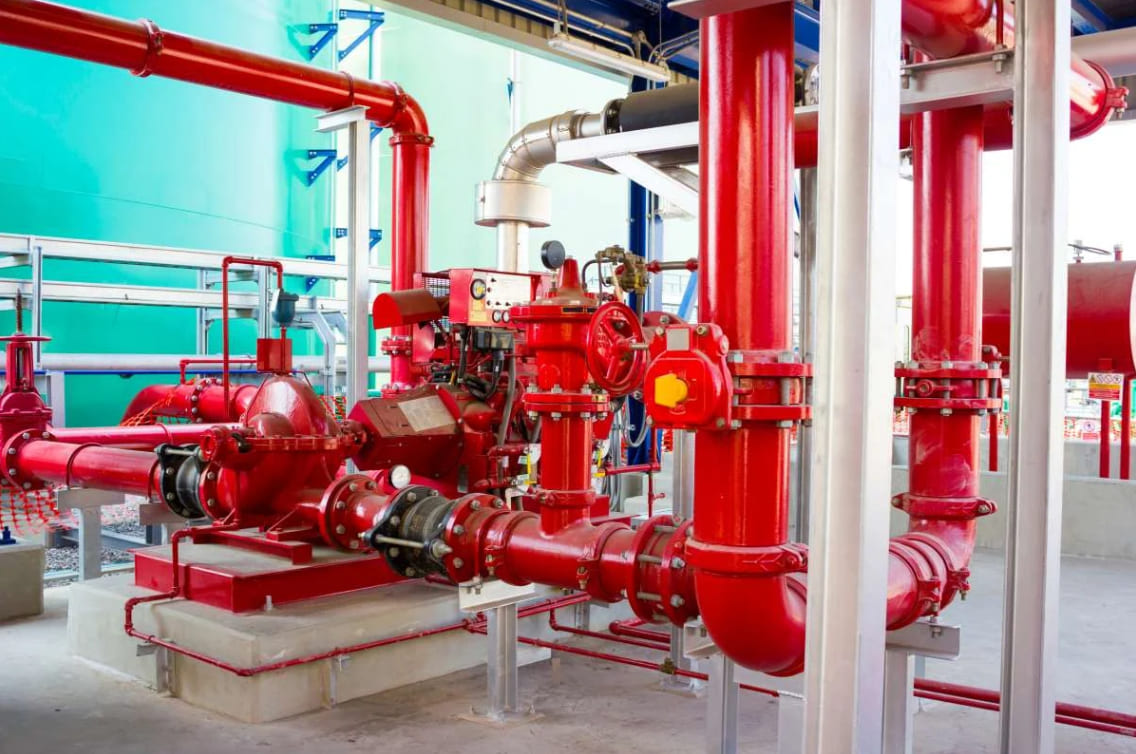Fire sprinkler systems are an essential component of building safety, designed to provide an immediate response to fire outbreaks and mitigate damage. A critical element within these systems is the fire pump, housed in the fire pump room. Fire pumps, which can be powered by electricity, diesel, or steam, play a vital role in ensuring that the sprinkler system functions effectively by supplying a high-pressure water flow to the sprinkler risers and fire hoses.
Fire pumps are connected to a municipal underground water pipe, serving as the primary source of water for the sprinkler system. This connection is crucial for maintaining a consistent and reliable water supply, especially in high-rise buildings and municipal wastewater facilities where the local water pressure is insufficient to meet the demands of the fire sprinkler system.

Picture|fire pump room
To ensure reliability and effectiveness, fire pumps must undergo rigorous testing and certification by third-party testing and certification organizations such as Underwriters Laboratories (UL) or Factory Mutual (FM). These certifications verify that the fire pump meets specific performance standards and can operate under the demanding conditions of a fire emergency.
In regions where building codes mandate an independent power source, fire pumps can be connected to transfer switches and emergency generators. This setup ensures that the fire pump remains operational even during a power outage, which is a common scenario during a fire due to the damage or safety protocols that cut off the building's primary power supply. The ability to switch to an emergency power source enhances the reliability of the fire protection system, providing peace of mind that the system will function when needed most.

Picture|Purity fire fighting system-PEDJ
One of the key features of a fire pump is its ability to automatically activate when the sprinkler system's pressure drops below a certain threshold. This pressure drop could occur when the sprinkler heads activate due to a fire, or when there is a malfunction or issue within the system, such as a problem with the fire hose reel or other fire connections. The automatic activation of the fire pump ensures that there is no delay in supplying water to the sprinkler system, which is critical for controlling and extinguishing fires in their early stages.
Additionally, fire pumps are designed to automatically release water when the sprinkler system's pressure exceeds its design temperature. This functionality prevents the system from being over-pressurized, which could cause damage to the sprinkler heads and other components. By maintaining optimal pressure levels, the fire pump helps ensure the longevity and reliability of the entire fire sprinkler system.
Municipal water systems often lack the pressure required to support a fire sprinkler system, especially in high-rise buildings or large municipal structures. Fire pumps address this issue by boosting the water pressure, making them an indispensable component of fire protection systems in such environments. The enhanced pressure provided by the fire pump ensures that water can reach all areas of the building, including the highest floors, delivering sufficient flow to control and extinguish fires effectively.

Picture|Purity fire fighting system-PEDJ Component
Fire pumps are widely used in high-rise buildings, municipal wastewater facilities, and other structures where reliable water pressure is critical for fire protection. The benefits of fire pumps extend beyond fire safety, as they also contribute to the overall resilience and safety of the building. By ensuring a steady supply of high-pressure water, fire pumps help protect lives and property, reduce the risk of extensive fire damage, and comply with building codes and safety regulations.
In conclusion, fire pumps are a vital component of fire sprinkler systems, providing the necessary water pressure to ensure effective fire suppression. Their ability to automatically activate and regulate pressure, along with the option to connect to independent power sources, makes them a reliable and essential part of building safety. The rigorous testing and certification by organizations like UL and FM further guarantee their performance under emergency conditions. By addressing the limitations of municipal water supplies, fire pumps play a crucial role in protecting high-rise buildings and other structures, making them an indispensable asset in modern fire protection systems.